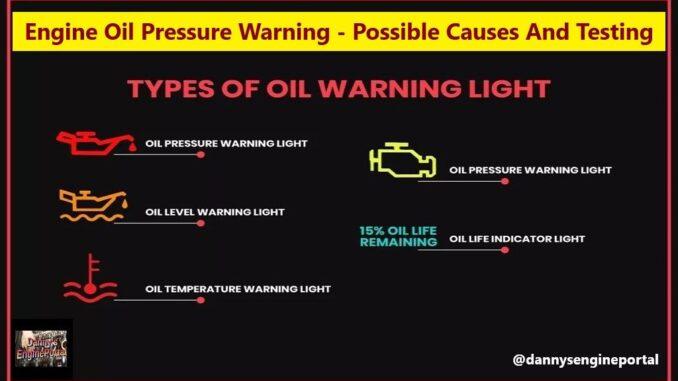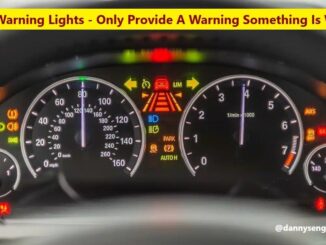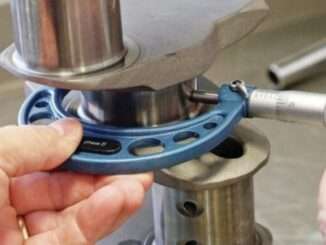
Suddenly, an engine oil pressure warning light or a low oil pressure reading, appears on your dash.
At that point, the engine oil pressure warning, is the only thing you should be thinking about.
Above all, you never want to ignore, any engine oil pressure warning light, especially if it stays on. Because, driving without the necessary level of oil, under the proper amount of pressure, will result in damage to your engine.
So, when you see an engine oil pressure warning, always check your oil level first.
Engine Oil Pressure Warning, Sensors
The engine oil pressure warning light system, receives its information from, an oil pressure sensor. And, is threaded into a major oil passage. Oil pressure troubleshooting should begin with, knowing how the system works. So, inside the oil pressure sensor, is a diaphragm, that is grounded, when there is little or no oil pressure.
Consequently, this is what causes, the warning light to light up. When the engine is running, the oil pressure pushes against the diaphragm and disconnects the ground. As a result, turning off the light. But, on more modern vehicles, the oil pressure sensor, actually sends an oil pressure value, to the (PCM).
So, if the oil pressure reading goes below a specified level, the powertrain control module (PCM) triggers the oil pressure warning light. And, in some cases, it shuts down the engine, in order to protect it mechanically. Some have a, Automatic Shutdown (ASD) Relay.
Some vehicles are able to distinguish between, low oil levels and insufficient oil pressure. This will let you know if the oil system is malfunctioning. And, sometimes, if you just need to add some more oil.
Below, are the most common symptoms, of a faulty oil pressure switch or sensor:
- Repeated blinking, from the oil pressure light
- The wrong reading, shows on the oil pressure gauge
- The oil pressure light, activates
If the oil level is between ADD and FULL, and the engine was running normally (no noise) after the oil pressure warning light came on. Then, the problem may be a defective, oil pressure sending unit, oil pressure gauge or warning light switch.
Troubleshooting, The Oil Pressure Gauge:
- Test the gauge, by grounding the wire that leads to the sending unit on the engine block.
- Then, with the key turned on or button pushed, watch the needle on the oil pressure gauge.
- Now, it should be either all the way high or all the way low.
- Grounding the wire should make the needle move to the opposite side of the gauge, from where it was.
- Before, the wire was grounded.
- If the vehicle has a oil pressure light, try touching the wire to ground.
- Then, removing the wire from ground, should turn the light on and off.
- If either happens, the gauge and wiring are good, confirming the sending unit is at fault.
Engine Oil Pump
The oil pump supplies the oil needed, to lubricate your engine when it is running. Oil pressure prevents metal-to-metal contact, between the engine parts.
Although the pump is one of the sturdiest parts in your vehicle, it is important to know the failing signs.
So, if the oil level is between ADD and FULL, and the engine was making noise when it was running, the problem may be a bad oil pump.
Testing Engine Oil Pressure, In Real Time
Remove the oil pressure sending unit on the engine and connect, a master oil pressure gauge, directly to the engine. Start the engine to see if the pump is generating adequate pressure.
So, if oil pressure is within specs (usually 10 psi for every 1000 rpm), the oil pump is okay. But, if pressure is less than the specs, the oil pump or engine bearings may be worn. Furthermore, you can also have, high oil pressure.
Other Possible Low Engine Oil Pressure Causes:
Oil Filter
An engine depends on an oil filter to protect it against, abrasions and wear. The job of the oil filter, is to screen out solid contaminants, from getting into the engine. These contaminants often include, metal particles, carbon, and dirt.
So, if they were to get inside the engine, they would cause damage to the engine. Your engine will then start to experience problems, as a result of this pressure change. That’s why, you must repair the problem right away, before it gets worse.
Oil Galleries, In The Engine
The oil pan or crankcase, is where the engine oil is stored. The oil capacity for the majority of engines, is between four and six quarts. The job of the engine oil pump, is to pressurize the oil and then circulate it. Once the oil leaves the pump, it will go straight to the oil filter for cleaning.
All the clean oil, will then pass through a series of passages, until it reaches the crankshaft. With oil galleries in the crankshaft, the oil is able to circulate through all the bearing surfaces of the engine.
Finally, always remember that actual oil pressure is created by, the resistance to oil flow.
In Summary: Engine Oil Pressure Warning
So, the engine oil pressure warning device, provides vital information to the driver. For instance, the engine oil pressure warning light coming on, after an oil change, is a serious problem. Because, it means that there is no oil, flowing inside the engine.
Thank You!




